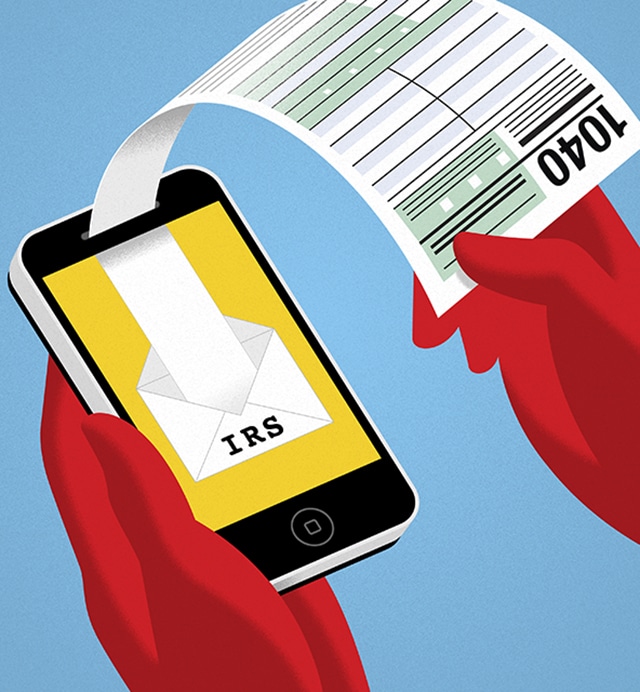The IRS is rolling out a free option for filing federal tax returns this year to some residents of a dozen states.
Last month, the agency published details of its plan to test an in-house filing system, in which taxpayers submit their federal tax returns directly to the agency online at no cost. Residents of 12 states are eligible to participate if they meet certain criteria.
“This is a critical step forward for this innovative effort that will test the feasibility of providing taxpayers a new option to file their returns for free directly with the IRS,” Danny Werfel, the agency’s commissioner, said in a recent statement.
While the direct filing system is starting on a limited basis, it has already faced some resistance, particularly from commercial tax preparation companies.
A spokesperson for Intuit, Tania Mercado, criticized the direct file project as a “half-baked solution” and a waste of taxpayer money. “The direct file scheme is a solution in search of a problem,” she said. Intuit makes the TurboTax tax preparation software.
Democrats in Congress generally support the idea of free, direct filing, while Republicans contend that the idea, part of President Joe Biden’s plan to overhaul the IRS, would give the agency even more power over ordinary taxpayers.
The direct file pilot will be open to low- and moderate-income taxpayers with simple returns. To be eligible, for instance, filers must take the standard deduction and have income limited to wages reported on Form W-2, Social Security or unemployment as well as interest income of $1,500 or less. Gig workers aren’t eligible. The IRS said in November that it expected “at least several hundred thousand taxpayers” to participate in what it called a “limited” pilot.
Many filers already have the option to prepare and submit free electronic returns based on their income, either through IRS Free File, a partnership with do-it-yourself tax software firms, or directly through some commercial providers. The IRS also provides online forms that any filers can use, regardless of income, to file returns at no cost.
The IRS Free File program, however, has had mixed results. The nonprofit newsroom ProPublica has reported, for instance, that Intuit’s TurboTax program steered users away from its free version. (Intuit no longer participates in IRS Free File, although it offers its software free to certain users.)
All those free options remain available, the IRS said, and its test version will just be another option. But with the new direct file service, the IRS aims to further streamline the filing process. In one possible scenario included in the agency’s report to Congress, the IRS could fill out tax returns with information it already has, like data from W-2 wage statements. For the pilot, however, participants will have to enter their own financial information, the IRS said.
The Inflation Reduction Act of 2022 ordered the IRS to study direct filing. In May, the agency submitted a report to Congress that found a majority of taxpayers would be interested in using a direct file tool, and it began preparing for a pilot test. In the report, the IRS estimated that the annual cost of a direct file system could range from $64 million to $249 million, depending on the scope of the service. (A separate report from the Treasury Department’s inspector general for tax administration, however, said that the design of the surveys conducted in the earlier report might have “overstated” taxpayer interest and that the department couldn’t determine the “reasonableness” of the agency’s cost estimates.)
The pilot system was built at the IRS by a team of tax experts, product managers, software engineers, designers and data scientists, according to the agency. The IRS said it was collaborating with special teams within the government that help agencies develop digital services.
The IRS says direct file will walk users through the steps of preparing a return, as commercial software does. The service will be “mobile friendly” and available in English and Spanish. Users can get help from the agency via a live online chat function and will have the option to speak with a customer service representative on the phone if needed.
In online summaries, the agency has said that to make sure the pilot works well, it will initially be opened to “a small group of taxpayers” during the 2024 filing season. As the season progresses, “more and more” eligible taxpayers will be able to use the service.
“We’re starting small to get it right,” the agency said in an update.
The IRS said it would promote the filing option in part through its network of grassroots and community partners, like the Volunteer Income Tax Assistance program, which provides free tax help for low- and moderate-income filers and for people with disabilities.
The agency said it planned to issue a public report on the pilot before deciding if the direct filing system should be opened to more taxpayers.
Here are some questions and answers about the upcoming tax filing season:
What states are included in the pilot?
Arizona, California, Florida, Massachusetts, Nevada, New Hampshire, New York, South Dakota, Tennessee, Texas, Washington state and Wyoming are participating. Most of those states don’t tax income at the state level, but the four that do — Arizona, California, Massachusetts and New York — will guide participants to a state-supported tool that they can use to submit their state returns.
“It’s exciting this is happening,” said Gabriel Zucker, associate policy director for tax benefits at Code for America, a nonprofit organization that builds digital tools to help taxpayers get access to government services. The group is building state electronic filing software for Arizona and New York that participants in the IRS pilot can use to file their state returns. “We do expect it can take the headache out of filing,” Zucker said.
According to an announcement from Gov. Kathy Hochul’s office, direct file users in New York will be able to share the information on their federal returns with Code for America’s filing tool. The tool will prepare most of the state return using the data provided, and most taxpayers will have to answer no more than a few simple questions to complete their New York return.
How soon can I file my income taxes this year?
The IRS hasn’t announced a start date for filing returns for tax year 2023, but it’s typically in late January. (Last year, filing season opened Jan. 23.)
When is the tax filing deadline this year?
The federal filing deadline for tax year 2023 returns is April 15 for most filers. State filing deadlines may vary.
c.2024 The New York Times Company. This article originally appeared in The New York Times.







